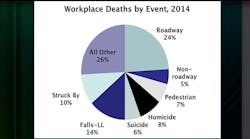Fifty years ago, President John F. Kennedy shared his vision to put a man on the moon. Now we’re talking about manned exploration to Mars. President Barack Obama announced a plan to cure cancer “once and for all.”
“These were all moonshots,” said National Safety Council (NSC) CEO and President Deborah Hersman in her opening remarks at the National Safety Congress and Expo in Anaheim earlier this week. “They came when someone said, ‘I do not care how hard it is. We are going to do it anyway. A moonshot is when you look at something important and decide: it’s not impossible, it just hasn’t been done yet.”
She went on to say that the NSC has announced its own moonshot: to eliminate preventable injuries in our lifetime. “We know this is a bold idea,” Hersman admitted, “but it’s one we cannot ignore.”
The United States is at an all-time high for preventable deaths. Four thousand happen in the workplace, but over 130,000 total preventable deaths occur each year.
The National Safety Council believes that all 130,000 preventable deaths can be eliminated, said Hersman.
While that task does seem impossible, she put it in terms that her audience could grasp. “If you think it’s possible to eliminate preventable deaths in our lifetime, please stand up,” she said. “If you think it’s possible to eliminate preventable deaths at your company, please stand up. If you think you can eliminate preventable deaths in your department, please stand up. In your team, please stand up.”
Eventually, every audience member was standing. “We CAN get to zero,” said Hersman, looking at the audience.
“If each of you focuses on that one moonshot for your team, we can eliminate preventable deaths in our lifetime. You don’t have to solve the big number. You just have to solve your number,” she said.
Hersman went on to talk about her number. On Feb. 25, 2006, her colleague at the National Transportation Safety Board, Brian Fiffick, died at the age of 33 in a car crash. “Although the crash didn’t happen on-the-job, it affected me, his colleagues and the entire organization as if it did,” Hersman remembered.
“For anyone who has gone through something similar… you know. The day your number becomes a name is the day your organization changes. You want to do everything possible to prevent another death from happening.”
“So who is your Brian, and where do we start?” she asked.
Start with Data
At the turn of the century, workplace deaths were commonplace. A woman in Pittsburgh started tracking workplace deaths in her city and discovered 500 workers died on the job in one year in that one city.
Today, workers are safer on the job than off, Hersman pointed out. “We are nine times more likely to die off-the-job than on-the-job. On any given day, the workplace is the safest place we are going to be.”
Pointing out that motor vehicle crashes remain the top cause of workplace deaths, Hersman suggested employer implement policies to ensure “employees are alert, attentive and sober while driving.”
“Although we didn’t know whether cell phone use was involved in Brian’s car crash, when I later became chairman of the NTSB, we put a cell phone policy in place to strengthen or safety system,” she said.
She also noted that according to the Insurance Institute for Highway Safety, 1 million car crashes could be prevented if all vehicles featured automatic emergency braking and forward collision warning. While 20 automakers announced they will add automatic braking systems by 2022, making it standard equipment in most cars, Hersman noted, “The technology is available today, how many of you will be the early adopters?”
She pointed to the dramatic reduction in occupational electrocutions from the 1980s to today as an example of public awareness and legislation working together to reduce fatalities. In 1980, there were 577 electrocutions and 80 percent were occurring in five industries: construction, repair services, grounds maintenance, transportation and agriculture. By the early 1990s, electrical fatalities had declined by 54 percent.
“The National Fire Protection Agency passed stronger codes to help companies protect their workers against shock and electrocution,” said Hersman, “and power companies launched large-scale awareness campaigns.”
While occupational electrocutions continue to occur, the number continues to decline because of these efforts, she said.
Opioids are killing workers, she noted, adding that employers such as Cummins, John Deere and ExxonMobil have expanded drug testing to include opioid painkillers, trained employees to spot signs of abuse and used employee assistant programs to help employees return to work after treatment.
Examine Causes of Injuries
“The solutions to your safety issues probably already exist,” said Hersman.
Hersman suggested safety leaders examine the leading causes of injuries at their facilities and among their team members. “Put your energies into solving those issues,” she suggested. “Remember, by focusing on your number, we can all get to zero.”
